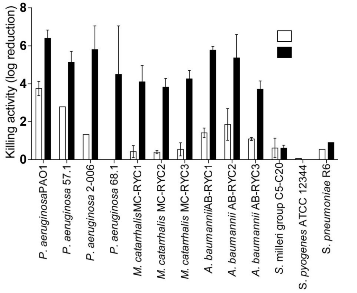CSIC has developed several polypeptides with bactericidal activity from a phage lysin of Pseudomonas aeruginosa. These compounds are particularly active against Gram-negative bacteria, such as P.
aeruginosa, Acinetobacter baumannii and Moraxella catarrhalis. The invention relates to these polypeptides for use in the treatment of diseases caused by bacteria, and preferably due to respiratory tract infections.
Industrial partners from the pharmaceutical sector are being sought to collaborate through a patent licence agreement.
New antibacterial agents for lower respiratory tract infections Lower respiratory tract infections caused about 3.2 million deaths worldwide in 2015 and they remain the deadliest reported diseases. Hospital-acquired pneumonia and ventilator-associated pneumonia are among the leading nosocomial infections worldwide, with an increasing frequency of multidrug resistant (MDR) Gram-negative bacteria, like Pseudomonas aeruginosa and Acinetobacter baumannii. Concerning public health issue, antimicrobial resistance (AMR), and associated morbidity and mortality data have been increasing globally. It has been estimated that AMR could produce about 10 million deaths a year by 2050. The WHO has called for global action on AMR, as search for alternatives to the currently used antibiotics. Phage lysins have been extensively tested as antibacterial agents. These enzymes break specific bonds of the bacterial peptidoglycan and display potent bactericidal activity, thus, they have been called “enzybiotics”. The inventors have obtained by biotechnology two new enzybiotics with high antimicrobial activity, particularly against a wide range of Gram-negative bacteria.
Bactericidal activity of enzybiotic 1 (white) and 2 (black). The bactericidal effect of 10 µM enzybiotic 1/2 in terms of logarithmic viable cell count difference with respect to the control is displayed for a range of clinically relevant bacteria.
Main innovations and advantages
· These two enzybiotics have a bactericidal activity, particularly active both against
· P. aeruginosa and A. baumannii, as well as other relevant pathogens such as
· M. catarrhalis or Streptococcus milleri group (SMG) bacteria.
· The strong activity of these enzybiotics has been obtained by bioengineering of the original polypeptides.
· One of the enzybiotics (white box in the picture) had a bactericidal activity, especially against · P. aeruginosa (up to 4-log killing) and A.baumannii (up to 2-log killing), and the second one (black box in the picture) activity was much higher with a killing activity ranging between 4 and 6 logarithmic units of viable cells reduction in all of the three tested · Gram-negative bacteria, P. aeruginosa, M. catarrhalis and A.baumannii.
· Further modifications of these two polypeptides can produce variants even more attractive for commercialization.








